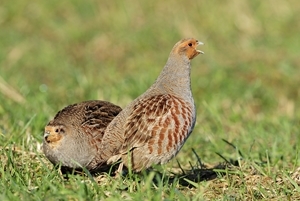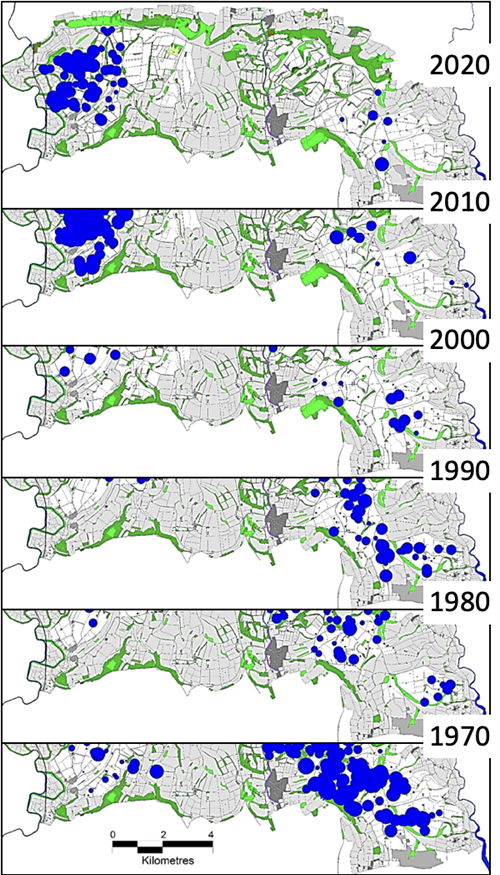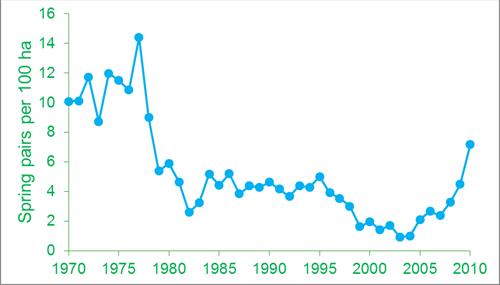 For the first 30 years of the Sussex study, the number of grey partridges declined, with a gradual loss across the study area (Figure 1). In 1970, the density of breeding pairs averaged 11.3 pairs per 100 hectares (250 acres). This nearly halved to just under six pairs (5.9) per 100 hectare in 1980. By 1990 numbers had slowly declined, with just over four and a half pairs per 100 hectares but there was another rapid decline in the next decade so that, by 2000, 100 hectares only held two grey partridge pairs. In 2004 there was an average of only a pair per 100 hectares. This was when things started to improve for grey partridges on the study area.
For the first 30 years of the Sussex study, the number of grey partridges declined, with a gradual loss across the study area (Figure 1). In 1970, the density of breeding pairs averaged 11.3 pairs per 100 hectares (250 acres). This nearly halved to just under six pairs (5.9) per 100 hectare in 1980. By 1990 numbers had slowly declined, with just over four and a half pairs per 100 hectares but there was another rapid decline in the next decade so that, by 2000, 100 hectares only held two grey partridge pairs. In 2004 there was an average of only a pair per 100 hectares. This was when things started to improve for grey partridges on the study area.
Figure 1: The changing distribution of grey partridge coveys on the Sussex study area. Each blue dot is the location of a partridge covey in autumn

Several landowners across the study area decided to implement management in order to counteract the decline of the grey partridge. The effects of this on the abundance of grey partridges across the study area are obvious in the map from 2010, with higher densities on the western side of the study area and retention of numbers on the eastern side. In 2010 the average breeding density across the study area was just over seven spring pairs per 100 hectares (Figure 2).
Figure 2: Spring pair density of grey partridges on the Sussex study area from 1970 to 2010. Since 2003/04 one of the farms on the study area has worked hard to restore densities of grey partridges

Further reading
- Ewald, J.A., Potts, G.R., & Aebischer, N.J. (2012). Restoration of a wild grey partridge shoot: a major development in the Sussex study, UK. Animal Biodiversity and Conservation, 35: 363-369.
- Potts, G.R. (2012). Partridges. Countryside Barometer. New Naturalist Library Book 121. Collins, London.
- Sotherton, N.W., Aebischer, N.J. & Ewald, J.A. (2010). The conservation of the Grey Partridge. In: Maclean, N. (ed.) Silent Summer: The State of Wildlife in Britain and Ireland: 319-336. Cambridge University Press, Cambridge.
- Potts, G.R. (2009). Restoring a grey partridge (Perdix perdix) population and the future of predation control. In: Cederbaum, S.B., Faircloth, B.C., Terhune, T.M., Thompson, J.J. & Carroll, J.P. (eds) Gamebird 2006: Quail VI and Perdix XII: 24-25. Warnell School of Forestry and Natural Resources, Athens, USA.
- Aebischer, N.J. & Ewald, J.A. 2004. Managing the UK Grey Partridge Perdix perdix recovery: population change, reproduction, habitat and shooting. Ibis, 146 Supplement 2: 181-191.
- Ewald, J.A., Aebischer, N.J. & Potts, G.R. 1998. Increasing Pesticide Use: Impacts on Wildlife Based on 30 years of Monitoring. In: Proceedings of the Wildlife, Pesticides, and People Conference, chapter 15: 1-16. Rachel Carson Council Inc, Fairfax, Virginia, USA.
- Potts, G.R. & Aebischer, N.J. 1991. Modelling the population dynamics of the Grey Partridge: conservation and management. In: Perrins, C.M., Lebreton, J.-D. & Hirons, G.J.M. (eds) Bird Population Studies: Their Relevance to Conservation Management: 373-390. Oxford University Press, Oxford.